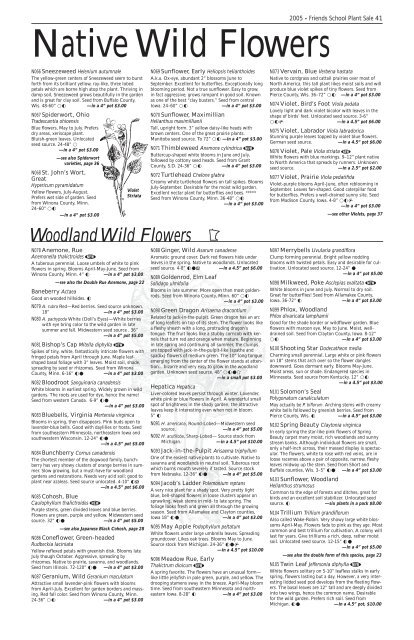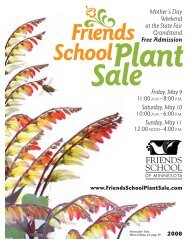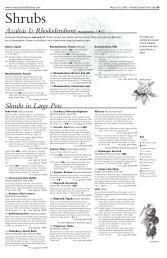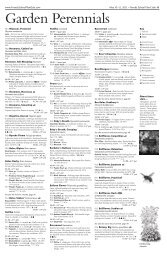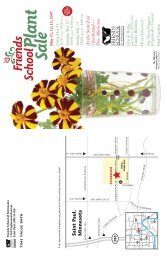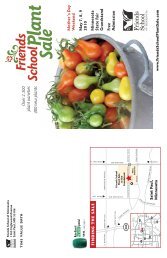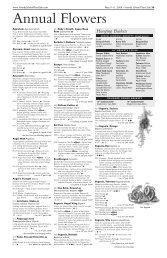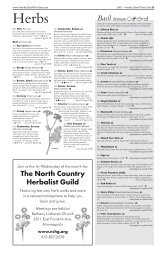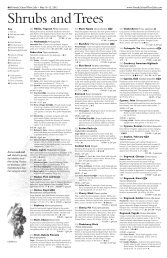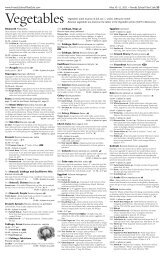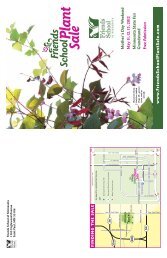<strong>2005</strong> • <strong>Friends</strong> <strong>School</strong> <strong>Plant</strong> <strong>Sale</strong> 41 Native Wild Flowers N066 Sneezeweed Helenium autumnale The yellow-green centers of Sneezeweed seem to burst forth from its brilliant yellow, ray-like, three lobed petals which are borne high atop the plant. Thriving in damp soil, Sneezeweed grows beautifully in the garden and is great for clay soil. Seed from Buffalo County, Wis. 48-60” Í∏ —in a 4” pot $3.00 N067 Spiderwort, Ohio Tradescantia ohioensis Blue flowers, May to July. Prefers dry areas, xeriscape plant. Bluish-green leaves. Unlocated seed source. 24-48” Í —in a 4” pot $3.00 —see also Spiderwort varieties, page 36 N068 St. John’s Wort, Great Hypericum pyramidatum Yellow flowers, July-August. Prefers wet side of garden. Seed from Winona County, Minn. 24–60” Í∏ —in a 4” pot $3.00 N078 Anemone, Rue Anemonella thalictroides ◊ A tuberous perennial. Loose umbels of white to pink flowers in spring. Blooms April-May-June. Seed from Winona County, Minn. 4” ∏ —in a 4” pot $3.00 —see also the Double Rue Anemone, page 22 Baneberry Actaea Good on wooded hillsides. ∏ Violet Striata N069 Sunflower, Early Heliopsis helianthoides A.k.a. Ox-eye, abundant 2” blossoms June to September. Excellent for butterflies. Exceptionally long blooming period. Not a true sunflower. Easy to grow, in fact aggressive; grows rampant in good soil. Known as one of the best “clay busters.” Seed from central Iowa. 24–60” Í∏ —in a 4” pot $3.00 N070 Sunflower, Maximillian Helianthus maximillianii Tall, upright form. 3” yellow daisy-like heads with brown centers. One of the great prairie plants. Manitoba seed source. To 72” Í∏ —in a 4” pot $3.00 N071 Thimbleweed Anemone cylindrica ◊ Buttercup-shaped white blooms in June and July, followed by cottony seed heads. Seed from Grant County, S.D. 24-36” Í∏ —in a 4” pot $3.00 N072 Turtlehead Chelone glabra Creamy white turtlehead flowers on tall spikes. Blooms July-September. Desirable for the moist wild garden. Excellent nectar plant for butterflies and bees. ***** Seed from Winona County, Minn. 36-48” Í∏ —in a 4” pot $3.00 Woodland Wild Flowers ˜ N079 A. rubra Red—Red berries. Seed source unknown. 18” —in a 4” pot $3.00 N080 A. pachypoda White (Doll’s Eyes)—White berries with eye bring color to the wild garden in late summer and fall. Midwestern seed source . 36” —in a 4” pot $5.00 N081 Bishop’s Cap Mitella diphylla ◊ Spikes of tiny, white, fantastically intricate flowers with fringed petals from April through June. Maple leafshaped basal foliage with 3” leaves. Moist soil, shade, spreading by seed or rhizomes. Seed from Winona County, Minn. 6-16” ∏Ó —in a 4” pot $3.00 N082 Bloodroot Sanguinaria canadensis White blooms in earliest spring. Widely grown in wild gardens. The roots are used for dye, hence the name! Seed from western Canada. 6-9” ∏Ó —in a 4” pot $3.00 N083 Bluebells, Virginia Mertensia virginica Blooms in spring, then disappears. Pink buds open to lavender-blue bells. Good with daylilies or hosta. Seed from southeastern Minnesota, northeastern Iowa and southwestern Wisconsin. 12-24” ∏Ó —in a 4.5” pot $5.00 N084 Bunchberry Cornus canadensis The shortest member of the dogwood family, bunchberry has very showy clusters of orange berries in summer. Slow growing, but a must-have for woodland gardens and restorations. Needs very acid soil; good to plant near azaleas. Seed source unlocated. 4-10” ∏˝ —in a 4.5” pot $6.00 N085 Cohosh, Blue Caulophyllum thalictroides ◊ Purple stems, green divided leaves and blue berries. Flowers are green, purple and yellow. Midwestern seed source. 32” ∏Ó —in a 4” pot $5.00 —see also Japanese Black Cohosh, page 28 N086 Coneflower, Green-headed Rudbeckia laciniata Yellow reflexed petals with greenish disk. Blooms late July though October. Aggressive, spreading by rhizomes. Native to prairie, savanna, and woodlands. Seed from Illinois. 72-120” ∏Ó —in a 4” pot $3.00 N087 Geranium, Wild Geranium maculatum Attractive small lavender-pink flowers with blooms from April-July. Excellent for garden borders and massing. Red fall color. Seed from Winona County, Minn. 24-36” Í∏ —in a 4” pot $3.00 N088 Ginger, Wild Asarum canadense Aromatic ground cover. Dark red flowers hide under leaves in the spring. Native to woodlands. Unlocated seed source. 4-8” ∏Ó˝ —in a 4.5” pot $6.00 N089 Goldenrod, Elm Leaf Solidago ulmifolia Blooms in late summer. More open than most goldenrods. Seed from Winona County, Minn. 60” Í∏ —in a 4” pot $3.00 N090 Green Dragon Arisaema dracontium Related to jack-in-the-pulpit. Green dragon has an arc of long leaflets on top of its stem. The flower looks like a fleshy sheath with a long, protruding dragon’s tongue. The fruit looks like a stubby corncob with kernels that turn red and orange when mature. Beginning in late spring and continuing all summer, the clumps are topped with jack-in-the-pulpit-like (spathe and spadix) flowers of medium green. The 10” long tongue emerging from the center of the flower stands at attention... bizarre and very easy to grow in the woodland garden. Unknown seed source. 48” Í∏Ó˜ —in a small pot $3.00 Hepatica Hepatica Liver-colored leaves persist through winter. Lavender, white pink or blue flowers in April. A wonderful small spot of brightness in the shady garden; the attractive leaves keep it interesting even when not in bloom. 5” ∏ N091 H. americana, Round-Lobed—Midwestern seed source. —in a 4” pot $5.00 N092 H. acutiloba, Sharp-Lobed— Source stock from Michigan. —in a 4.5” pot $10.00 N093 Jack-in-the-Pulpit Arisaema triphyllum One of the easiest native plants to cultivate. Native to savanna and woodlands in neutral soil. Tuberous root which burns mouth severely if tasted. Source stock from Nebraska. 12-36” ∏Ó —in a 4” pot $5.00 N094 Jacob’s Ladder Polemonium reptans A very nice plant for a shady spot. Very pretty light blue, bell-shaped flowers in loose clusters appear on sprawling, weak stems in mid- to late spring. The foliage looks fresh and green all through the growing season. Seed from Allamakee and Clayton counties, Iowa 18” ∏Ó —in a 4” pot $3.00 N095 May Apple Podophyllum peltatum White flowers under large umbrella leaves. Spreading groundcover. Likes oak trees. Blooms May to June. Source stock from Michigan. 24-36” ∏Ó´ —in a 4.5” pot $10.00 N096 Meadow Rue, Early Thalictrum dioicum ◊ A spring favorite. The flowers have an unusual form— like little jellyfish in pale green, purple, and yellow. The drooping stamens sway in the breeze. April-May bloom time. Seed from southeastern Minnesota and northeastern Iowa. 8-28” ∏ —in a 4” pot $3.00 N073 Vervain, Blue Verbena hastata Native to cordgrass and cattail prairies over most of North America, this tall plant likes moist soils and will produce blue violet spikes of tiny flowers. Seed from Pierce County, Wis. 36–72” Í∏ —in a 4” pot $3.00 N074 Violet, Bird’s Foot Viola pedata Lovely light and dark violet bicolor with leaves in the shape of birds’ feet. Unlocated seed source. 3-6” Í∏´ —in a 4.5” pot $6.00 N075 Violet, Labrador Viola labradorica Stunning purple leaves topped by violet blue flowers. German seed source. —in a 4.5” pot $6.00 N076 Violet, Pale Viola striata ◊ White flowers with blue markings. 9–12” plant native to North America that spreads by runners. Unknown seed source. —in a 2.5” pot $2.00 N077 Violet, Prairie Viola pedatifida Violet-purple blooms April-June, often reblooming in September. Leaves fan-shaped. Good caterpillar food for butterflies. Prefers a well-drained sunny site. Seed from Madison County, Iowa. 4-8” Í∏´ —in a 4” pot $3.00 —see other Violets, page 37 N097 Merrybells Uvularia grandiflora Clump forming perennial. Bright yellow nodding blooms with twisted petals. Easy and desirable for cultivation. Unlocated seed source. 12-24” Ó —in a 4” pot $5.00 N098 Milkweed, Poke Asclepias exaltata ◊ White blooms in June and July. Normal to dry soil. Great for butterflies! Seed from Allamakee County, Iowa. 36-72” ∏ —in a 4” pot $3.00 N099 Phlox, Woodland Phlox divaricata lamphamii Good for the shade border or wildflower garden. Blue flowers with maroon eye, May to June. Moist, welldrained soil. Seed from Clayton County, Iowa. 8-12” Í∏ —in a 4” pot $3.00 N100 Shooting Star Dodecatheon media Charming small perennial. Large white or pink flowers on 18” stems that arch over so the flower dangles downward. Goes dormant early. Blooms May-June. Moist areas, sun or shade. Endangered species in Minnesota. Seed source from Kentucky. 12” Í∏ —in a 4.5” pot $3.00 N101 Solomon’s Seal Polygonatum canaliculatum May actually be P. biflorum. Arching stems with creamy white bells followed by greenish berries. Seed from Pierce County, Wis. ∏ —in a 4.5” pot $3.00 N102 Spring Beauty Claytonia virginica In early spring the star-like pink flowers of Spring Beauty carpet many moist, rich woodlands and sunny stream banks. Although individual flowers are small, only a half-inch across, their massed display is spectacular. The flowers, white to rose with red veins, are in loose racemes above a pair of opposite, narrow, fleshy leaves midway up the stem. Seed from Short and Buffalo counties, Wis. 3–5” ∏Ó —in a 4” pot $3.00 N103 Sunflower, Woodland Helianthus strumosus Common to the edge of forests and ditches, great for birds and an excellent soil stabilizer. Unlocated seed source. ∏ —six plants in a pack $8.00 N104 Trillium Trillium grandiflorum Also called Wake-Robin. Very showy large white blossoms April-May. Flowers fade to pink as they age. Most common and best trillium for cultivation. A colony will last for years. Give trilliums a rich, deep, rather moist soil. Unlocated seed source. 12-15” ∏Ó —in a 4” pot $5.00 —see also the double form of this species, page 23 N105 Twin Leaf Jeffersonia diphylla ◊ White flowers solitary on 5-10” leafless stalks in early spring, flowers lasting but a day. However, a very interesting lidded seed pod develops from the fleeting flowers. The basal leaves are 12” tall and are deeply divided into two wings, hence the common name. Desirable for the wild garden. Prefers rich soil. Seed from Michigan. ∏Ó —in a 4.5” pot, $10.00
42 <strong>Friends</strong> <strong>School</strong> <strong>Plant</strong> <strong>Sale</strong> • <strong>2005</strong> Index by Common Name Vegetables have been omitted from indexing; see pages 14–15 A Ageratum, Ageratum, 6 Allium, Yellow, Alllium, 26 Aloe, Aloe, 16 Aloinopsis, Aloinopsis, 26 Alyssum, Sweet, Lobularia, 6 Amaranthus, Amaranthus, 6 Anemone, Anemone, 26 Anemone, Rue, Anemonella, 41 Anemone, Rue Double, Anemonella, 22 Angel Mist, Angelonia, 6 Angelica, Angelica, 39 Angelica, Korean, Angelica, 26 Angel’s Trumpet, Tree-Form, Brugmansia, 11 Anise Hyssop, Agastache, 39 Apache Plume, Fallugia, 26 Aralia, Variegated, Acanthopanax, 19 Arrowhead, White-Flowered, Sagittaria, 35 Arrowwood, Blue Muffin, Viburnum, 18, 19 Artemisia, Artemisia, 26 Artichoke, Globe, Cynara, 6 Asarina, Red Dragon, Asarina, 25 Asiatic Lily, Lilium, 33 Asparagus Fern, Asparagus, 8 Asparagus, Vining, Asparagus, 25 Aster, Aster (perennial), 26 Aster, New England, Aster, 26, 39 Aster (annual), Aster, 6 Aster, Prairie Golden, Heterotheca, 26 Aster (native), Aster, 39 Astilbe, Astilbe, 26 Avens, Geum, 26 Azalea, Rhododendron, 20 B Baby’s Breath (annual), Gypsophila, 6 Baby’s Breath (perennial), Gypsophilia, 26 Bachelor’s Buttons, Centaurea, 26 Bacopa, Bacopa, 8 Balloon Flower, Platycodon, 26 Banana, Musa, 11 Baneberry, Actaea, 41 Barrenwort, Epimedium, 22, 26 Basil, Ocimum, 16 Bay Laurel, Laurus, 16 Bayberry, Myrica, 19 Bear’s Breeches, Acanthus, 26 Beardtongue (perennial), Penstemon, 26, 27 Beardtongue, Large-flowered, Penstemon, 39 Bee Balm, Monarda, 27 Begonia, Begonia, 6 Bellflower, Campanula, 27 Bellflower, Tall, Campanula, 39 Bells of Ireland, Molucella, 6 Bergamot, Wild, Monarda, 39 Betony, Big, Stachys, 27 Birch, Betula, 18, 19 Birdsfoot Trefoil, Double, Lotus, 27 Bishop’s Cap, Mitella, 41 Black-eyed Susan (annual), Rudbeckia, 6 Black-Eyed Susan (native), Rudbeckia, 39 Black-Eyed Susan (perennial), Rudbeckia, 27 Blanket Flower (perennial), Gaillardia, 27 Blanket Flower (annual), Gaillardia, 6 Blazing Star (perennial), Liatris, 27 Blazing Star (native), Liatris, 39 Bleeding Heart, Dicentra, 27 Bleeding Heart, Climbing, Adlumnia, 25 Bloodroot, Sanguinaria, 41 Blue Grama Grass, Bouteloua, 12 Blue Joint Grass, Calamgrostis, 12 Blue-Eyed Grass, Sisyrinchium, 39 Bluebells, Virginia, Mertensia, 41 Blueberries, Vaccinum, 14 Bluestar, Amsonia, 27 Bluestem, Big, Andropogon, 12 Bluestem, Little, Schizachyrium, 12 Borage, Borago, 16 Bottlebrush Grass, Hystrix, 12 Bowman’s Root, Gillenia, 27 Bridal Veil, Tripogandra, 8 Brome, Fringed, Bromus, 12 Brome, Kalm’s, Bromus, 12 Brown-Eyed Susan, Rudbeckia, 39 Brunnera, Heartleaf, Brunnera, 27 Bugleweed, Ajuga, 28 Bugloss, Anchusa, 28 Bunchberry, Cornus, 41 Bunny Tails, Lagurus, 8 Burnet, Greater, Sanguisorba, 28 Burnet, Salad, Sanguisorba, 16 Bush Clover, Weeping, Lespedeza, 28 Bush Honeysuckle, Diervilla, 18 Buttercup, Groundcover, Ranunculus, 28 Butterfly Bush (annual), Buddleia, 6 Butterfly Bush (perennial), Buddleia, 28 Butterfly Flower, Asclepias, 6 Butterfly Weed (native), Asclepias, 39 Butterfly Weed (perennial), Asclepias, 28 Button Bush, Cephalanthus, 19 C Cabbage, Flowering, Brassica, 6 Calendula, Calendula, 6 Canary Bird Vine, Tropaeolum, 25 Canna Lily, Canna, 6 Canterbury Bells (perennial), Campanula, 28 Caper Bush, Capparis, 16 Caragana, Walker, Caragana, 20 Caraway, Carum, 16 Cardinal Climber, Ipomoea, 25 Cardinal Flower (annual), Lobelia, 6 Cardinal Flower (native), Lobelia, 39 Cardinal Flower (perennial), Lobelia, 28 Castor Bean, Ricinus, 6 Catmint, Nepeta, 28 Catnip, Nepeta, 16 Cattail, Dwarf, Typha, 35 Cedar, Thuja, 18, 19 Chamomile, Matricaria, 16 Chervil, Anthriscus, 16 Chinese Lanterns, Physalis, 28 Chives, Allium, 16 Chocolate Vine, Akebia, 25 Chokeberry, Glossy Black, Aronia, 18 Chrysanthemum, Silver and Gold, Chrysanthemum, 28 Cilantro, Coriandrum, 16 Cinquefoil, Potentilla, 28 Clematis, Clematis, 24 Clivia, Clivia, 11 Cockscomb, Celosia, 6 Coffee, Coffea liberica, 16 Cohosh, Black, Actaea, 28 Cohosh, Blue, Caulophyllum, 41 Cohosh, Japanese Black, Actaea, 28 Coleus, Solenostemon scutellariodies, 6, 7 Columbine, Aquilegia, 28, 29 Columbine, False, Semiaquilegia, 29 Columbine, Wild, Aquilegia, 39 Compass <strong>Plant</strong>, Silphium, 39 Coneflower (perennial), Echinacea, 29 Coneflower (native), Echinacea, 39 Coneflower, Green-headed, Rudbeckia, 41 Coneflower, Yellow, Ratibida, 39 Coral Bells, Heuchera, 29 Coreopsis (perennial), Coreopsis, 29 Coreopsis, Prairie, Coreopsis, 39 Corydalis, Corydalis, 22, 29 Cosmos, Cosmos, 7 Cranberry, American Highbush, Viburnum, 18 Cranesbill, Geranium, 29 Culver’s Root, Veronicastrum, 39 Culver’s Root, Blue, Veronicastrum, 29 Cup and Saucer Vine, Cobaea, 25 Cup Flower, Nierembergia, 7 Cup <strong>Plant</strong>, Silphium, 40 Cupid’s Dart, Catananche, 29 Cypress, False, Chamaecyparis, 18, 19 Cypress, Russian, Microbiota, 18 D Dahlia, Dahlia, 7 Daisy, Mat, Anacyclus, 29 Daisy, Shasta, Leucanthemum, 29 Daisy, Swan River, Brachyscome, 7 Daisy, Thread Petal, Inula, 29 Daphne, Daphne, 19 Daylily, Hemerocallis, 30 Delphinium (annual), Delphinium, 7 Delphinium (perennial), Delphinium, 29 Dill, Anethum, 16 Dock, Bloody, Rumex, 30 Dock, Prairie, Silphium, 40 Dogwood, Cornus, 18, 19 Dropseed, Sporobolus, 12 Dusty Miller, Senecio, 7 Dutchman’s Pipe, Aristolochia, 25 E Elderberry, Sambucus, 19 Epazote, Chenopodium, 16 Eucalyptus, Eucalyptus, 7 F Fairy Bells, Disporum, 30 Fame Flower, Talinum, 30 Feather Reed Grass, Calamagrostis, 12 Fennel, Foeniculum, 16 Fern, Adiantum, Athyrium, Dryopteris, Matteuccia, Onoclea, Osmunda, Polystichum, 31 Fescue, Festuca, 12 Fig, Turkey, Ficus, 11 Flame Flower, Celosia, 7 Flamingo Flower, Celosia, 7 Flax, Blue, Linum, 30 Flax, New Zealand, Phormium, 8 Flora’s Paintbrush, Emilia, 7 Foamflower, Tiarella, 30 Foamy Bells, Heucherella, 30 Forget-Me-Nots, Myosotis, 30 Forsythia, Forsythia, 19 Forsythia, White, Abeliophyllum, 19 Fountain Grass, Pennisetum, 12 Four O’Clocks, Mirabilis, 7 Foxglove, Digitalis, 30 Fringecups, Tellima, 30 Fuchsia, Narrowleaf, Zauschneria, 30 G Garlic, German, Allium, 16 Gas <strong>Plant</strong>, Dictamnus, 30 Gentian, Bottle, Gentiana, 40 Gentian, Nikita, Gentiana, 30 Geranium, Pelargonium, 7 Geranium, Scented, Pelargonium, 16 Geranium, Wild, Geranium, 41 Ginger, European, Asarum, 30 Ginger, Japanese Wild, Asarum, 22 Ginger, Upright Wild, Saruma, 30 Ginger, Wild, Asarum, 41 Globe Amaranth, Gomphrena, 7 Globe Flower, Trollius, 31 Globe Thistle, Echinops, 31 Goatsbeard, Aruncus, 31 Golden Marguerite, Anthemis, 31 Goldenbush, Narrowleaf, Ericameria, 31 Goldenrod, Elm Leaf, Solidago, 41 Goldenrod, Golden Baby, Solidago, 31 Goldenrod, Showy, Solidago, 40 Goldenrod, Stiff, Solidago, 40 Goldenrod, Variegated, Solidago, 31 Goldenrod, Zigzag, Solidago, 40 Gooseneck, Purple, Lysimachia, 31 Green Dragon, Arisaema, 41 H Harebells, Campanula, 40 Hazelnut, American, Corylus, 18 Heliotrope, Heliotropium, 7 Hellebore, Helleborus, 22, 31 Hens and Chicks, Sempervivum, 31 Hens and Chicks, Mongolian, Orostachys, 31 Hepatica, Hepatica, 41 Hibiscus, Hibiscus, 31 Hickory, Shagbark, Carya, 20 Holly, Blue, Ilex, 19 Hollyhock, Alcea, 31 Hollyhock, French, Malva, 31 Hollyhock, Mountain, Illiamna, 7 Hollyhock, Queeny Purple, Alcea, 7 Honeysuckle, Goldflame, Lonicera, 25 Honeysuckle, Honey Rose, Lonicera, 19 Honeysuckle, Japanese, Lonicera, 25 Honeysuckle, Miniglobe, Lonicera, 18 Honeysuckle, Scarlet Trumpet, Lonicera, 25 Honeysuckle, Trumpet, Lonicera, 25 Horehound, Black, Ballota, 16 Horseradish, Armoracia, 16 Horsetail, Equisetum, 35 Hosta, Hosta, 28 Hummingbird Mint (annual), Agastache, 7 Hummingbird Mint (perennial), Agastache, 31 Hyacinth, Water, Eichornia, 35 Hydrangea, Hydrangea, 18, 19 Hydrangea, Climbing, Hydrangea, 25 Hydrangea Vine, Japanese, Schizophragma, 25 I Ice <strong>Plant</strong>, Yellow, Delosperma, 31 Impatiens, Impatiens, 9 Indian Grass, Sorghastrum, 12 Indigo, Blue, Baptisia, 31 Indigo, Cream Wild, Baptisia, 40 Indigo, White Wild, Baptisia, 40 Indigo, Yellow, Thermopsis, 32 Iris, Bearded, Iris, 32 Iris, Crested, Iris, 32 Iris, Dwarf, Iris, 32 Iris, Dwarf Wild, Iris, 32 Iris, Japanese, Iris, 32 Iris, Northern Blue Flag, Iris, 40 Iris, Purple Flag, Iris, 22 Iris, Siberian, Iris, 32 Iris, Southern Blue Flag, Iris, 40 Iris, Spuria, Iris, 32 Iris, Variegated, Iris, 32 Ironweed, Vernonia, 40 Ivy, German, Senecio, 8 J Jack-in-the-Pulpit, Arisaema, 41 Jack-in-the-Pulpit, Japanese, Arisaema, 22 Jacob’s Ladder (native), Polemonium, 41 Jacob’s Ladder (perennial), Polemonium, 32 Japanese Forest Grass, Hakonechloa, 12 Jewels of Opar, Talinum, 7 Joe Pye Weed (native), Eupatorium, 40 Joe Pye Weed (perennial), Eupatorium, 32 Joe Pye Weed, Sweet, Eupatorium, 40 Johnny Jump-ups, Viola, 8 June Grass, Koeleria, 12 Jupiter’s Beard, Centranthus, 32 K Kale, Flowering, Brassica, 8 Kangaroo Flower, Anizoganthus, 11 King’s Crown, Rhodiola, 32 Kiwi, Hardy, Actinidia, 25 Knotweed, Dragon, Persicaria, 32 L Lady’s Mantle, Alchemilla, 32 Lady’s Slipper, Cypripedium, 22, 23 Lady’s Tresses, Fragrant, Spiranthes, 23 Lamb’s Ear, Stachys, 32 Lamium, Lamium, 32 Larkspur, Prairie, Delphinium,40 Lavender, Lavandula, 17 Leadplant, Amorpha, 40 Lemon Balm, Melissa, 16 Lemon Grass, Cymbopogon, 16 Leopard’s Bane, Doronicum, 32 Lewisia, Siskiyou, Lewisia, 32 Licorice <strong>Plant</strong>, Helichrysum, 8 Ligularia, Ligularia, 32 Lilac, Cutleaf, Syringa, 19 Lily, Blackberry, Belamcanda, 32 Lily, Candy, Pardancanda, 32 Lily, Leopard, Lilium, 33 Lily, Madonna, Lilium, 33 Lily, Martagon, Lilium, 23 Lily, Michigan, Lilium, 40 Lily of the Nile, Agapanthus, 11 Lily of the Valley, Convallaria, 32 Lily, Turk’s Cap, Lilium, 33 Lion’s Foot, Prenanthes, 41 Lisianthus, Lisianthus, 8 Lobelia, Compact, Lobelia, 8 Lobelia, Great Blue, Lobelia, 40 Lobelia, Trailing, Lobelia, 8 Loosestrife, Whorled, Lysimachia, 32 Lovage, Levisticum, 16 Love in a Mist, Nigella, 8 Love Lies Bleeding, Amaranthus, 8 Love-in-a-Puff, Cardiospermum, 25 Lungwort, Pulmonaria, 32 Lupine, Lupinus, 33 Lupine, Wild, Lupinus, 40 Lupine, Yellow, Thermopsis, 33 M Magnolia, Magnolia, 18 Magnolia Vine, Chinese, Schisandra, 25 Maiden Grass, Miscanthus, 12 Mallow, Hollyhock, Malva, 33 Mallow, Prairie, Sidalcea, 33 Maltese Cross, Lychnis, 33 Maple, Flowering, Abutilon, 8 Maple, Tree-Form Flowering, Abutilon, 11 Marigold, Tagetes, 10 Marjoram, Sweet, Origanum, 16 Marsh Helleborine, Epipactus, 23 Marsh Marigold, Caltha, 40 Marshmallow, Alcea, 33 May Apple, Podophyllum, 41 Meadow Rue, Thalictrum, 33, 34 Meadow Rue, Early, Thalictrum, 41 Meadow Rue, Purple, Thalictrum, 40 Meadow Saffron, Bulbocodium, 34 Meadowsweet, Filipendula, 34 Merrybells, Uvularia, 41 Mexican Hat, Ratibida, 40 Milk Vetch, Canadian, Astragalus, 40 Milkweed, Poke, Asclepia, 41 Milkweed, Asclepias, 40 Milkwort, Box-Leaved, Polygala, 34 Millet, Purple Majesty, Pennisetum, 12 Million Bells, Calibrachoa, 8 Mina, Mina, 25 Mint, Mentha, 16, 17 Mint, Lemon, Monarda, 17 Mint, Water, Mentha, 35 Mockorange, Philadelphus, 18 Money <strong>Plant</strong>, Lunaria, 34 Moneywort, Lysimachia, 34 Monkey Flower (annual), Mimulus, 8 Monkey Flower (native), Mimulus, 40 Monkey Flower, Rocky Mountain, Mimulus, 34 Monkshood, Aconitum, 34 Monkshood Vine, Ampelopsis, 25 Moonflower, Climbing, Ipomoea, 25 Moor Grass, Molina, 12 Morning Glory, Ipomoea, 25 Morning Glory, Bush, Ipomoea, 34 Moss, Irish, Sagina, 34 Moss Rose, Portulaca, 8 Mullein, Purple, Verbascum, 34 Mum, Garden, Chrysanthemum, 34 N Nasturtium, Tropaeolum, 8 Nasturtium, Climbing, Tropaeolum, 25 Nemesia, Nemesia, 8 New Jersey Tea, Ceanothus, 18 Northern Sea Oats, Chasmanthium, 12 O Oat Grass, Blue, Helictotrichon, 12 Obedient <strong>Plant</strong>, Physostegia, 34 Onion, Curly, Allium, 34 Onion, Egyptian Walking, Allium, 17 Onion, Mars, Allium, 34 Onion, Prairie, Allium, 40 Orchis, Showy, Orchis, 23 Oregano, Origanum, 17 Oregano, Hop-Flowerered, Origanum, 34 Oriental Lily, Lilium, 33 P Pachysandra, Pachysandra, 34 Painted Tongue, Salpiglossis, 8 Palm, Umbrella, Cyperus, 35 Pampas Grass, Hardy, Saccharum, 12 Pansy, Viola, 9 Papyrus, Dwarf, Cyperus, 35 Parsley, Petroselinum, 17 Parsley, Purple Leaf Japanese, Cryptotaenia, 34 Pasque Flower (native), Anemone, 40 Pasque Flower (perennial), Anemone, 34 Patchouli, Pogostemon, 17 Pearly Everlasting, Anaphalis, 40 Pennyroyal, Mentha, 17 Penstemon, Electric Blue, Penstemon, 9 Peony, Paeonia, 34 Peony, Anomalous, Paeonia, 23 Peony, Chinese Mountain, Paeonia, 23 Peony, Fern-Leaf, Paeonia, 23 Peony, Intersectional, Paeonia, 23 Peony, Japanese Forest, Glaucidium, 23 Peony, Scarlet, Paeonia, 23 Peony, Wittmann’s, Paeonia, 23 Peony, Woody, Paeonia, 23 Peony, Yellow, Paeonia, 23 Perilla, Perilla, 9 Periwinkle, Vinca, 34 Periwinkle, Turkish, Vinca, 34 Persian Shield, Strobilanthes, 9 Petunia, Petunia, 11 Petunia, Wild , Ruellia, 40 Phacelia, Silky, Phacelia, 34 Phlox, Creeping, Phlox, 34 Phlox, Garden, Phlox, 34, 35 Phlox, Prairie, Phlox, 40 Phlox, Woodland, Phlox, 41 Pickerel Rush, Pontederia, 35 Pimpernel, Anagallis, 9 Pincushion Flower, Scabiosa, 35 Pineapplelily, Eucomia, 11 Pinks (annual), Dianthus, 9 Pinks (perennial), Dianthus, 35 Polka Dot, Hypoestes, 9 Poppy, Black Peony, Papaver, 9 Poppy, California, Eschscholzia, 9 Poppy, Iceland, Papaver, 35 Poppy, Oriental, Papaver, 35 Poppy, Plume, Macleaya, 35 Poppy, Snow, Eomecon, 35 Poppy, Wood, Stylophorum, 35 Poppy, Yellow Horned, Glaucium, 35 Prairie Clover, Purple, Petalostemum, 40 Prairie Smoke, Geum, 40 Prickly Pear, Opuntia, 40 Primrose, Primula, 35 Primrose, Evening, Oenothera, 35 Prince’s Plume, Stanley, 35 Pussy Willow, Salix, 18 Pussy Willow, Weeping, Salix, 20 Pussytoes, Antennaria, 40 Pussytoes, Red, Antennaria, 35 Q Quaking Grass, Briza, 12 Quamash, Camassia, 35 Queen Anne’s Lace, Daucus, 9 Queen of the Meadow, Filipendula, 35 Queen of the Prairie, Filipendula, 35 R Rattlesnake Master, Eryngium, 40 Red Shiso, Perilla, 17 Redbud, Cercis, 20 Rhododendron, Rhododendron, 20 Rhubarb, Ornamental, Rheum, 36 Rock Cress, Purple, Aubrieta, 36 Rock Cress, White, Arabis, 36 Rock Rose, Helianthemum, 36 Rock Soapwort, Saponaria, 36 Rockfoil, Saxifraga, 36 Rodger’s Flower, Rodgersia, 36 Rose, Rosa, 13 Rosemary, Rosmarinus, 17 Royal Catchfly, Silene, 40 Ruby Grass, Rhynchelytrum, 12 Rush, Juncus, 12 Rush, Japanese, Acorus, 12 S Sage, Culinary, Salvia, 17 Sage, Flowering, Salvia, 36 Sage, Jerusalem, Phlomis, 36 Sage, Lyre-Leaved, Salvia, 36 Sage, Meadow, Salvia, 36 Sage, Prairie, Artemisia, 40 Sage, Russian, Perovskia, 36 Salvia (annual), Salvia, 9 Salvia, Feathered, Salvia, 36 Samur Lily, Lilium, 33 Satin Flower, Godetia, 9 Savory, Satureja, 17 Saxifraga, Heartleaf, Bergenia, 36 Sea Holly, Eryngium, 36 Sea Lavender, Limonium, 36 Sea Thrift, Armeria, 36 Sedge, Carex, 12 Senna, Wild, Cassia, 36 Serviceberry, Regent, Amelanchier, 18 Shamrock, Purple, Trifolium, 36 Shepherds’ Scabiosa, Jasione, 36 Shieldleaf, Astilboides, 36 Shooting Star, Dodacatheon, 41 Side-oats Grama, Bouteloua, 12 Silver Sage, Salvia, 9 Smokebush, Cotinus, 19 Snakeroot, Chocolate, Eupatorium, 36 Snapdragon, Antirrhinum, 9 Snapdragon, Spanish, Antirrhinum, 9 Snapdragon, Trailing, Antirrhinum, 10 Snapdragons, Mini, Linaria, 36 Sneezeweed (perennial), Helenium, 36 Sneezeweed (native), Helenium, 41 Snowberry, Symphoricarpus, 18 Soloman’s Seal, Variegated, Polygonatum, 36 Solomon’s Seal, Polygonatum, 41 Sorrel, French, Rumex, 17 Spiderflower, Cleome, 10 Spiderwort, Ohio, Tradescantia, 40 Spiderwort (perennnial), Tradescantia, 36 Spikenard, American, Aralia, 17 Spikes, Cordyline, 8 Spikes, Dracaena, 8 Spirea, Japanese, Spirea, 36 Spring Beauty, Claytonia, 41 Spurge, Allegheny, Pachysandra, 36 Spurge (annual), Euphorbia, 10 Spurge (perennial), Euphorbia, 36 St. John’s Wort, Hypericum, 41 Statice, German, Limonium, 36 Stevia, Stevia, 17 Stonecrop, Sedum, 36, 37 Strawberry, Pink Flowering, Fragaria, 37 Strawberry, Fragaria, 14 Sumac, Fragrant, Rhus, 19 Summersweet, Ruby Spice, Clethra, 18 Sun Daisy, Osteospermum, 10 Sundrops, Oenothera, 37 Sunflower, Downy, Helianthus, 37 Sunflower, Early, Heliopsis, 41 Sunflower, Maximillian, Helianthus, 41 Sunflower, Mexican, Tithonia, 10 Sunflower, Woodland, Helianthus, 41 Sweet Cicely, Myrrhis, 17 Sweet Grass, Hierchloe, 12 Sweet Pea, Everlasting, Lathyrus, 25 Sweet Potato Vine, Ipomoea, 8 Sweet William, Dianthus, 37 Sweet Woodruff, Galium, 37 Switch Grass, Panicum, 12 T Tamarack, Larix, 20 Taro, Colocasia, 10 Tarragon, French, Artemisia, 17 Thimbleweed, Anemone, 41 Thistle, Giant, Cephalaria, 37 Throatwort, Blue, Trachelium, 10 Thyme, Thymus, 17 Toad Lily, Japanese, Tricyrtis, 37 Tobacco, Flowering, Nicotiana, 10 Trillium, Trillium, 37, 41 Trillium, Grandiflorum ‘Plenum’, Trillium, 23 Trumpet Lily, Lilium, 33 Tufted Hair Grass, Deschampsia, 12 Turtlehead, Chelone, 41 Twin Leaf, Jeffersonia, 41 V Vanilla Grass, Anthoxanthum, 12 Verbena, Verbena, 10 Verbena, Brazilian, Verbena, 11 Verbena, Clump, Verbena, 37 Verbena, Lemon, Aloysia, 17 Veronica, Veronica, 37 Vervain, Blue, Verbena, 41 Viburnum, Onondaga, Viburnum, 18 Vinca, Catharanthus, 10 Vinca Vines, Vinca, 8 Violet, Bird’s Foot, Viola, 41 Violet, Labrador, Viola, 41 Violet, Pale, Viola, 41 Violet (perennial), Viola, 37 Violet, Prairie, Viola, 41 Virgin’s Bower, Clematis, 25 W Weigela, Weigela, 19 Willow, Dappled, Salix, 19 Willow, Dwarf Arctic, Salix, 19 Willowherb, Alpine, Epilobium, 37 Winecups, Callirhoe, 37 Wishbone Flower, Torenia, 11 Wisteria, Wisteria, 25 Woodrush, Greater, Luzula, 12 Y Yarrow, Achillea, 37 Yellow Archangel, Lamiastrum, 37 Yew, Margarita, Taxus, 19 Yucca, Yucca, 37 Z Zinnia, Zinnia, 11 Zinnia, Creeping, Sanvitalia, 11


